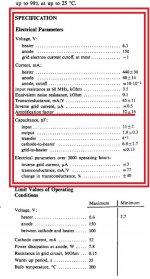Last edited:
Can you post the complete circuit?
I dont have a circuit.
I would like to calculate if the 6c45p gain is enough to drive the 300B.
Santiago
Thanks RAYMA , the same circuit could be fine.
You start with the drive requirements for the 300B, then work backwards and setup the 300B to deliver that voltage plus some extra margin.
If you bias your 300B at -70V, then you want 70V+ peak drive voltage.
Given the tube parameters and circuit components, you can then calculate the actual amplification factor of the driver tube. It will rarely ever be the actual listed mu. If we assume that your 6C45P has a gain in circuit of 35x, then that tells you that you better have more than 2V of bias on the driver tube so you can get at least 70V peak out of it.
If you bias your 300B at -70V, then you want 70V+ peak drive voltage.
Given the tube parameters and circuit components, you can then calculate the actual amplification factor of the driver tube. It will rarely ever be the actual listed mu. If we assume that your 6C45P has a gain in circuit of 35x, then that tells you that you better have more than 2V of bias on the driver tube so you can get at least 70V peak out of it.
I read the thread but could not draw a clear conclusion.
Also used RC coupling and I have interstage transformer with the posibility to step up 1:2.
The only clear thing is that the 300b needs 180Vpp
Also used RC coupling and I have interstage transformer with the posibility to step up 1:2.
The only clear thing is that the 300b needs 180Vpp
What's your 300B operating point? Are you putting a linestage in front of the amp, or will this be an integrated?
What are the rest of the parameters of the 300B voltages and current?
Plate voltage
Plate current
Bias voltage
90V bias is the only reason for needing 180V peak to peak from the driver circuit.
90V Bias sounds like you are pushing the 300B to the absolute limits of plate voltage,
and plate dissipation, in order to get maximum power out. You are likely going to get short life from the 300B.
A guitar amp might abuse an output tube, but hopefully a Hi Fi amp will not.
Perhaps you are referring to the "300B" tubes in the above link in post # 4 above ( Built my first 300B amp - have lots of questions! )
Those tubes that are pictured in post # 1 of that link are NOT 300B tubes. They are a souped up modern triode.
Plate voltage
Plate current
Bias voltage
90V bias is the only reason for needing 180V peak to peak from the driver circuit.
90V Bias sounds like you are pushing the 300B to the absolute limits of plate voltage,
and plate dissipation, in order to get maximum power out. You are likely going to get short life from the 300B.
A guitar amp might abuse an output tube, but hopefully a Hi Fi amp will not.
Perhaps you are referring to the "300B" tubes in the above link in post # 4 above ( Built my first 300B amp - have lots of questions! )
Those tubes that are pictured in post # 1 of that link are NOT 300B tubes. They are a souped up modern triode.
Last edited:
What's your 300B operating point? Are you putting a linestage in front of the amp, or will this be an integrated?
I would use some dac with 1.5v out .
The 300B will work with 395VCC 75-80mA
I would use some dac with 1.5v out .
The 300B will work with 395VCC 75-80mA
395V of B+ or 395V plate to cathode?
400V plate to cathode and 90V of bias gets you about 45mA of plate current and requires a pretty high impedance output transformer (~5K). For these conditions a 6C45P with about 3V of grid bias and a plate loading resistor of at least 10K would handle things just fine.
400V of B+ and 90V of bias leaves 300V P-K and a bias current that's too low for proper operation.
I would mention that finding a good 5K transformer is more difficult than finding a good 3K transformer, but if you happen to have a good 5K transformer that's gapped for about 50mA and will handle the power, then this would all make sense.
395V of B+ or 395V plate to cathode?
400V plate to cathode and 90V of bias gets you about 45mA of plate current and requires a pretty high impedance output transformer (~5K). For these conditions a 6C45P with about 3V of grid bias and a plate loading resistor of at least 10K would handle things just fine.
400V of B+ and 90V of bias leaves 300V P-K and a bias current that's too low for proper operation.
I would mention that finding a good 5K transformer is more difficult than finding a good 3K transformer, but if you happen to have a good 5K transformer that's gapped for about 50mA and will handle the power, then this would all make sense.
I have in my hands Lundahl OPT 3k 8ohms
LL1664 SE 80mA
- Home
- Amplifiers
- Tubes / Valves
- How to calculate gain for a driver tube amplifier.
